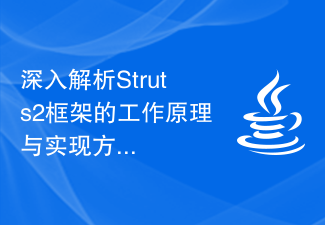 Web Front-end
Web Front-end JS Tutorial
JS Tutorial Understand the five caching mechanism implementation methods of JavaScript
Understand the five caching mechanism implementation methods of JavaScript
In-depth understanding: Five implementation methods of JS caching mechanism, specific code examples are required
Introduction:
In front-end development, the caching mechanism is to optimize web page performance one of the important means. Through reasonable caching strategies, requests to the server can be reduced and user experience improved. This article will introduce the implementation of five common JS caching mechanisms, with specific code examples so that readers can better understand and apply them.
1. Variable caching
Variable caching is the most basic and simplest caching method. By storing the results of one-time calculations in variables, repeated calculations are avoided and operating efficiency is improved.
Code example:
function calculate() {
var result = 0; // 将计算结果存储在 result 变量中
// 复杂的计算逻辑
return result;
}
var cachedValue = calculate(); // 第一次计算并缓存结果
console.log(cachedValue);
// 后续使用缓存结果
console.log(cachedValue);
console.log(cachedValue); 2. Local storage cache
The local storage cache saves the data in the browser’s local storage and reads the local storage directly the next time the data is obtained. There is no need to request the server again, which can reduce network transmission time.
Code example:
// 存储数据
localStorage.setItem('key', 'value');
// 获取数据
var cachedValue = localStorage.getItem('key');
console.log(cachedValue); 3. Memory cache
Memory cache saves data in memory and can be read quickly, but it is only valid on the current page and will be refreshed after the page is refreshed. Empty.
Code example:
var cache = {}; // 使用对象作为缓存容器
// 存储数据
cache['key'] = 'value';
// 获取数据
var cachedValue = cache['key'];
console.log(cachedValue);4. HTTP caching
HTTP caching is implemented by setting the Cache-Control and Expires fields in the response header, which allows the browser to cache the requested resources. , the cached resource will be returned directly when requested again.
Code example:
// 设置响应头
res.setHeader('Cache-Control', 'max-age=3600'); // 设置缓存有效期为1小时
res.setHeader('Expires', new Date(Date.now() + 3600000).toUTCString());
// 后续请求将直接返回缓存的资源 5. CDN caching
CDN caching publishes static resources to CDN nodes and quickly responds to requests through nodes close to users to reduce server pressure.
Code sample: None
Conclusion:
The above introduces the five implementation methods of JS caching mechanism, including variable caching, local storage caching, memory caching, HTTP caching and CDN caching. Different caching methods are suitable for different scenarios. Developers can choose appropriate caching strategies according to actual needs to optimize web page performance and improve user experience. However, it should be noted that the caching mechanism may cause data consistency and update problems, so you need to consider carefully when using caching.
The above is the detailed content of Understand the five caching mechanism implementation methods of JavaScript. For more information, please follow other related articles on the PHP Chinese website!
 PHP中的OAuth2鉴权方法及实现方式Aug 07, 2023 pm 10:53 PM
PHP中的OAuth2鉴权方法及实现方式Aug 07, 2023 pm 10:53 PMPHP中的OAuth2鉴权方法及实现方式随着互联网的发展,越来越多的应用程序需要与第三方平台进行交互。为了保护用户的隐私和安全,许多第三方平台使用OAuth2协议来实现用户鉴权。在本文中,我们将介绍PHP中的OAuth2鉴权方法及实现方式,并附上相应的代码示例。OAuth2是一种授权框架,它允许用户授权第三方应用程序访问其在另一个服务提供商上的资源,而无需提
 深入解析Struts2框架的工作原理与实现方式Jan 05, 2024 pm 04:08 PM
深入解析Struts2框架的工作原理与实现方式Jan 05, 2024 pm 04:08 PM解读Struts2框架的原理及实现方式引言:Struts2作为一种流行的MVC(Model-View-Controller)框架,被广泛应用于JavaWeb开发中。它提供了一种将Web层与业务逻辑层分离的方式,并且具有灵活性和可扩展性。本文将介绍Struts2框架的基本原理和实现方式,同时提供一些具体的代码示例来帮助读者更好地理解该框架。一、框架原理:St
 PHP实现直播功能的三种方式May 21, 2023 pm 11:00 PM
PHP实现直播功能的三种方式May 21, 2023 pm 11:00 PM随着互联网的普及和高速网络的加速,直播已经成为了一种非常流行的互联网应用。直播能够为用户提供实时的视频和音频流,并能够进行互动和交流,因此在各种社交平台和在线教育中广泛应用。而在直播应用中,PHP也是一种非常重要的编程语言之一,很多网站和应用都使用PHP来实现直播功能。本文将介绍PHP实现直播功能的三种方式。一、使用RTMP协议RTMP(RealTime
 PHP7.0中的响应式编程有哪些实现方式?May 27, 2023 am 08:24 AM
PHP7.0中的响应式编程有哪些实现方式?May 27, 2023 am 08:24 AM在过去的几十年中,计算机编程已经经历了许多变化和进化。其中一个最新的编程范式被称为响应式编程(reactiveprogramming),它在高质量、高并发的Web应用程序开发中变得更加流行。PHP是一种流行的Web编程语言,提供了丰富的库和框架来支持响应式编程。在本文中,我们将介绍PHP7.0中响应式编程的实现方式。什么是响应式编程?在开始讨论PHP7.0
 PHP7.0中的国际化支持有哪些实现方式?May 27, 2023 am 08:31 AM
PHP7.0中的国际化支持有哪些实现方式?May 27, 2023 am 08:31 AMPHP是一种广泛应用于Web开发的编程语言,而在Web开发中,多语言和国际化是非常重要的一部分。PHP7.0的最新版本中有许多实现多语言和国际化的新特性,本文将探讨PHP7.0中的国际化支持有哪些实现方式。一、多语言支持在Web应用中,有不同语言的用户使用,为了让用户可以方便地访问这些应用,并能够以自己的语言学习和交流,我们就需要为用户提供多种语言的界面。这
 uniapp中如何实现混合开发Oct 27, 2023 pm 04:03 PM
uniapp中如何实现混合开发Oct 27, 2023 pm 04:03 PMUniapp是一种基于Vue.js的框架,可以实现跨平台的混合开发。在Uniapp中,我们可以使用一套代码开发同时适配多个平台,如微信小程序、H5、Android、iOS等。本文将介绍uniapp中如何实现混合开发,并提供具体的代码示例。一、uniapp开发环境搭建首先,我们需要安装uniapp的开发环境。具体步骤如下:安装Node.js,Uniapp依赖N
 如何在PHP中实现RESTful API的身份验证Sep 06, 2023 pm 12:00 PM
如何在PHP中实现RESTful API的身份验证Sep 06, 2023 pm 12:00 PM如何在PHP中实现RESTfulAPI的身份验证RESTfulAPI是一种常用的互联网应用程序接口设计风格。在实际开发中,为了保护API的安全性,我们通常需要对用户进行身份验证。本文将介绍在PHP中实现RESTfulAPI的身份验证的方法,并给出具体的代码示例。一、基本认证(BasicAuthentication)基本认证是最简单的一种身份验证方式,
 PHP7.0中的内存管理有哪些实现方式?May 26, 2023 pm 07:01 PM
PHP7.0中的内存管理有哪些实现方式?May 26, 2023 pm 07:01 PMPHP是一门广受欢迎的编程语言,目前最新版的PHP是PHP7.0。在新版本的PHP中,内存管理是一个重要而且值得关注的话题。本文将探讨PHP7.0中的内存管理以及其实现方式。内存管理简介内存管理是指计算机系统在运行时对内存空间的分配、使用、回收等各种操作的管理。在编程语言中,内存管理扮演着至关重要的角色。对于PHP这样的动态语言来说,内存的分配和释放对性能影


Hot AI Tools

Undresser.AI Undress
AI-powered app for creating realistic nude photos

AI Clothes Remover
Online AI tool for removing clothes from photos.

Undress AI Tool
Undress images for free

Clothoff.io
AI clothes remover

AI Hentai Generator
Generate AI Hentai for free.

Hot Article

Hot Tools

Atom editor mac version download
The most popular open source editor

MantisBT
Mantis is an easy-to-deploy web-based defect tracking tool designed to aid in product defect tracking. It requires PHP, MySQL and a web server. Check out our demo and hosting services.

Dreamweaver Mac version
Visual web development tools

PhpStorm Mac version
The latest (2018.2.1) professional PHP integrated development tool

Safe Exam Browser
Safe Exam Browser is a secure browser environment for taking online exams securely. This software turns any computer into a secure workstation. It controls access to any utility and prevents students from using unauthorized resources.





